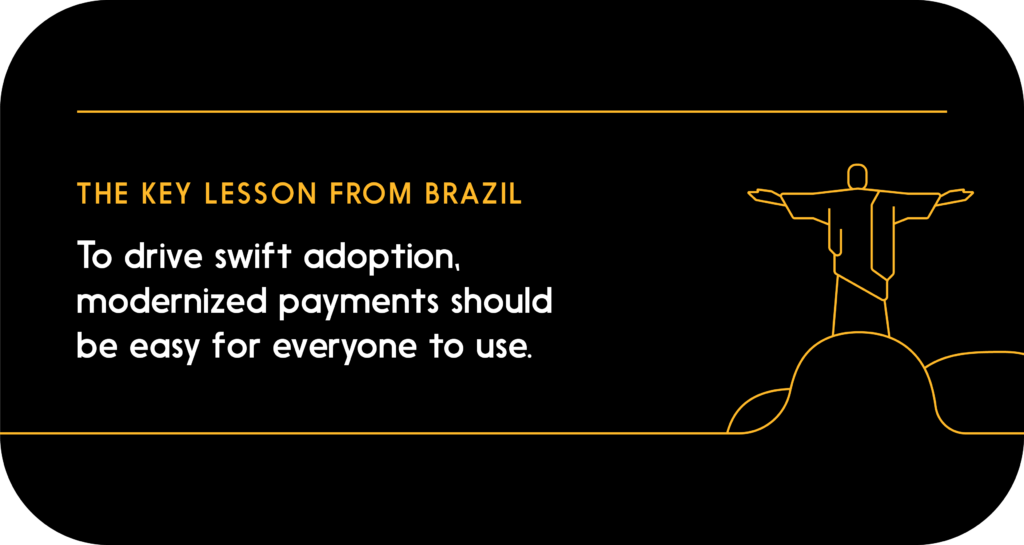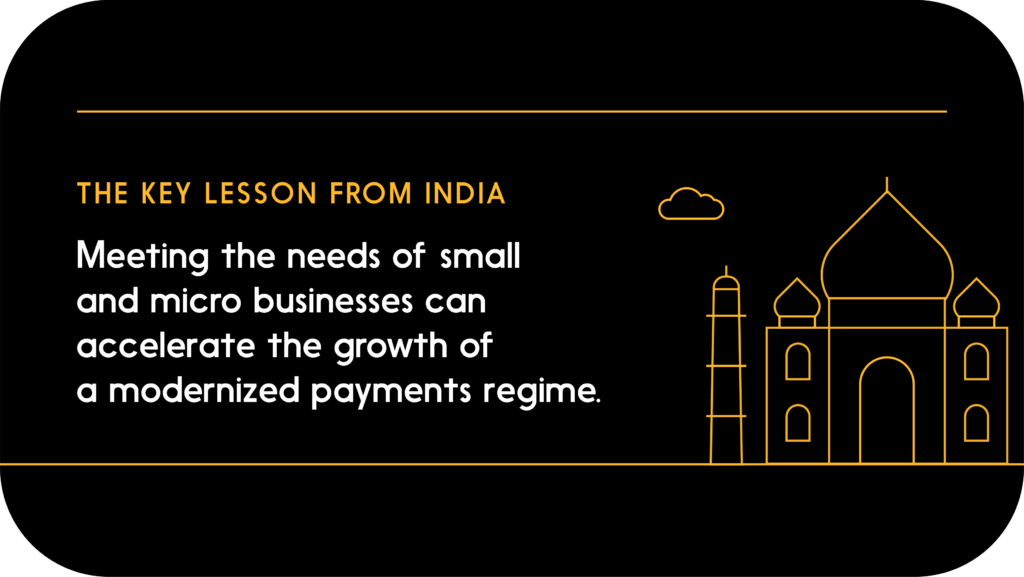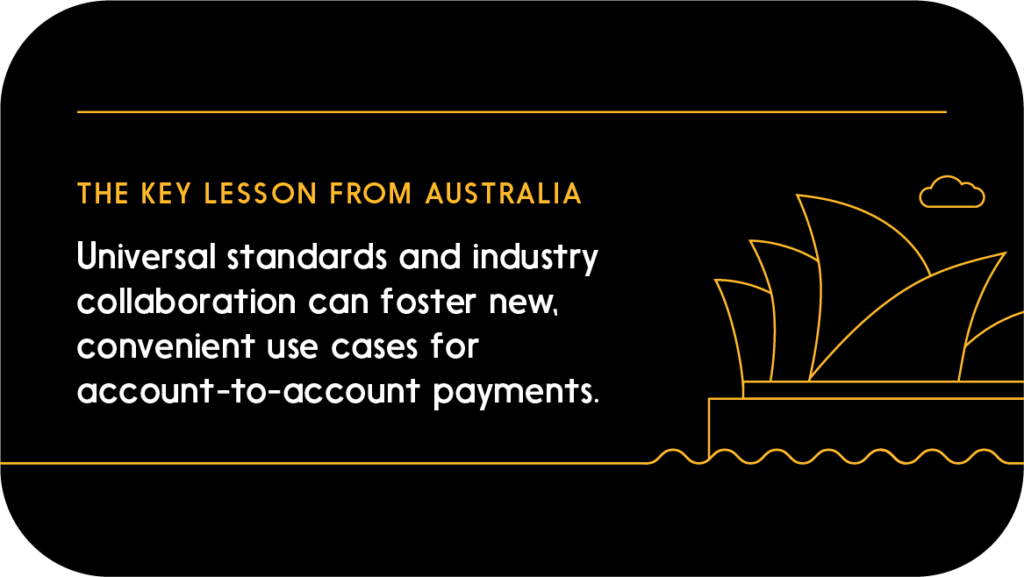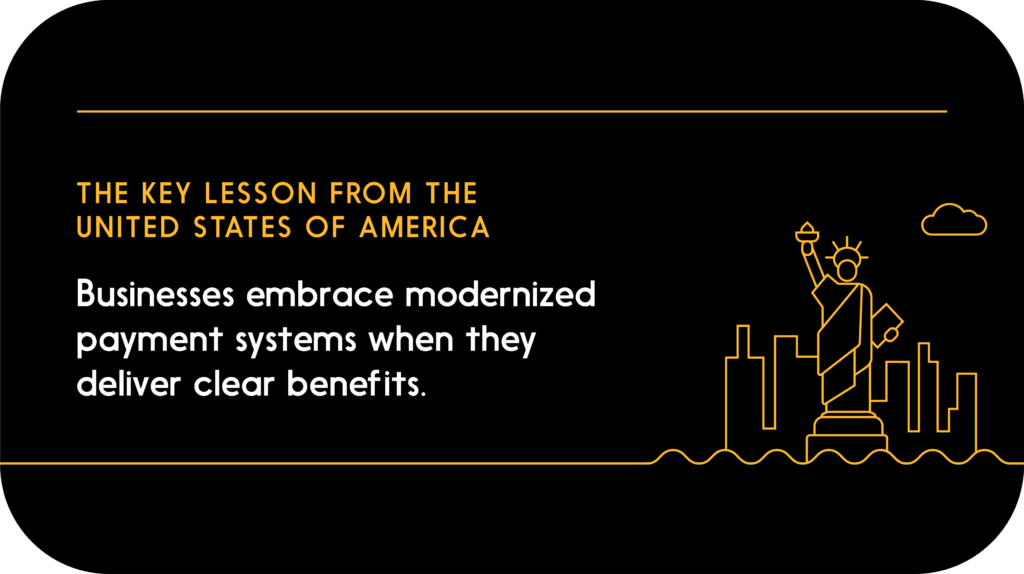In a world of instant, account-to-account payments, money moves at a faster velocity, improving cash flow for businesses, creating convenient experiences, and lessening the economy’s reliance on credit. More of the world is now living that reality: As of 2022, 60 countries, representing 72 per cent of the world’s population, had access to real-time payment systems according to one tally.
The global advance of modernized payments systems that offer instant clearing and settlement of funds is a technical accomplishment for the financial system, but it’s also much more than that: It’s a march toward greater convenience and opportunity for everyone.
Countries with real-time payment systems bring a lot of overlapping goals to payments modernization, and there are parallels in their experiences. Canada can look abroad for lessons in successful implementation — the Canadian economy can hope to reap many of the same benefits as other countries have as it continues to modernize its payments infrastructure.
What’s driving the movement toward modernized payments?
Canadian businesses recognize a need for modernized payments that enable them to compete globally, and that can integrate seamlessly into their operations. Switching from cheques and to faster payment methods can help make business processes more efficient and catalyze competition and innovation within the broader ecosystem.
And modernized payments bring other benefits, too, including cross-border flows (to connect domestic systems with the global marketplace, enabling money to move more easily around the world), access to rich remittance data to help businesses better manage their operations, and improvements to security and fraud prevention.
These needs and desires exist in other markets, too — as we’ll see, they’re relevant just about everywhere in the world.
Take the United States, for example: A 2023 survey of business leaders by US Bank found that adoption of real-time payments in several sectors (retail, travel and hospitality, and healthcare) was largely driven by a desire to enhance customer service, improve cash flow, and make reconciliation instant. Modernized payments can also address pain points: For example, among small- to medium-sized U.S. businesses, PYMNTS research discovered a mismatch between SMB buyers (38 per cent of which tend to pay by cheque, or by ACH, a U.S. form of EFT ) and SMB suppliers, which would prefer faster channels.
And so on in other markets: When developing its Pix instant payment system, the Brazilian central bank considered lower financial costs, increased security, improved customer experience, and higher market competition and efficiency among its objectives — all of which would sound familiar in Canada, despite the vast differences between our two markets.
Four real-time payment case studies: Brazil, India, the United States and Australia
As Canada continues to modernize and update its payments infrastructure, what kind of results from other countries should we look for — and what kinds of lessons can we learn about successful implementations? Let’s look at interesting developments in four markets, each on a different continent:
Brazil: Inclusivity leads to rapid, wide adoption
When Brazil’s Pix system launched in November 2020, proponents hoped to modernize a largely cash-based economy. They faced a daunting task: Tens of millions of Brazilians had no experience of digital payments prior to Pix.
Yet within the first two and a half years, Pix had been used by 140 million individuals, or about 80 per cent of Brazil’s adult population.
What did the Brazilian central bank do right? Among other things, it made inclusivity (that is, increasing financial inclusion) a key driving principle guiding Pix. The initiative was successful in part because of a user experience that observers said was positive from Day One.
This rapid adoption has set the stage for the growth of Brazil’s digital economy — as has been the case with India, the next example we’ll see.

India: Rapid rise of the digital economy thanks to UPI
India launched the United Payments Interface (UPI) in 2016 to help transform a cash-dominated economy into a digital one. As in Brazil, India’s National Payments Corporation (a joint effort by the central bank and the banking association) focused on making the system easy to use, embracing ubiquity and simplicity (aided by a largely QR code-based interface), interoperability, and a “free public good” approach that includes little-to-no fees for merchants and none for consumers.
As in Brazil, making digital payments more accessible has been a rousing success. The UPI system processed almost US$2-trillion in payments in 2022, making it the largest real-time payments network in the world.
Amidst this rapid digital transformation, small businesses have been major beneficiaries: Lending based on cash flow data has allowed them to prove their income to potential lenders in a way that wasn’t possible before, which has opened up borrowing opportunities — and potential for growth.
For businesses of all sizes, UPI has led to the development of comprehensive solutions, including POS systems, mobile payment and e-commerce payment options. All of this has streamlined businesses’ payment processes and enhanced consumer choice around payments.
In the bigger picture, India’s digital economy has boomed in its era of instant payments, from 8 per cent of GDP in 2018 to an estimated 18-23 per cent by 2025. This expansion has coincided with a rise in fintechs and equity capital flows into fintech, a trend that is expected to only further accelerate India’s transition to a digital economy.

Australia: Use cases have proliferated, with the platform operator’s support
Australia, a country that resembles Canada in many ways, adopted its New Payments Platform (NPP) in 2018. Like the other modernized payments initiatives covered in this article, NPP has been a success: According to a recent government report, it processed more than a billion transactions in a 12-month period ending in 2022, representing more than a quarter of all account-to-account transactions (a key metric, given the Australian government’s goal of phasing out cheques).
As a senior member of the NPPA (the platform operator) explained in an interview, the NPP’s growth has been fuelled in part by the development of new use cases. Whereas the NPP was originally conceived as a means for consumers and merchants to pay each other easily, the system now facilitates many use cases for many people, including underpinning a share-trading app, allowing governments to deliver relief aid payments quickly, and enabling companies to pay employees in real time. Microbusinesses, meanwhile, are using NPP to take payments on the go, using smartphones.
To encourage these kinds of innovations, the NPPA has taken an active role by setting out rules and standards for financial institutions and fintechs to follow when developing new products and experiences — setting out data formatting standards for certain types of transactions, for example.

USA: Businesses have been quick to realize the benefits
The United States currently has two schemes: the Real-Time Payments (RTP) system, launched in 2017, and FedNow, launched in 2023.
Now that businesses have had several years to take advantage of RTP, PYMNTS.com and The Clearing House — a banking association that runs RTP — surveyed US executives to discover the benefits that early adopters have experienced.
Early adopters cited a long list. The benefits they mentioned included better cash flow (cited by 24 per cent as the most important benefit, and by another 51 per cent as an important benefit but not the most important); increased accounting efficiency (7.7 per cent most important; 46 per cent important); more efficiency in reconciliation tasks (7 per cent most important; 42 per cent important). Other benefits cited included easier integration of accounts payable, accounts receivable and enterprise resource planning systems; easier payment tracking; and mitigated risk of payment failure.
While the cost of adoption was the downside mentioned most often, 54 per cent of organizations surveyed “expect to have lower costs once they introduce new features made possible by RTP transfers, meaning these upgrades may very well pay for themselves in compressed time.”
All in all, the PYMNTS.com/Clearing House survey found that 86 per cent of businesses generating US$500 million to $1 billion in revenue were taking advantage of RTP to send real-time payments as of 2022. And in a separate PYMNTS poll earlier this year, sixty-one percent of U.S. executives said they believed real-time payments would give them a competitive advantage — especially in a world where customers expect speed. In other words, adoption spreads as more and more businesses come to understand and experience the advantages that real-time payments bring them.

Modernized payments in Canada
Canada has a strong record of payment innovation and adoption, from being early adopters of debit and peer-to-peer money transfer transactions to more recent milestones: Canadians made a billion Interac e-Transfer transactions in a 12-month period for the first time as of April 2022, and they followed that with more than a billion Interac Debit on mobile transactions in 12 months ending July 2023.
Today, Interac e-Transfer already offers Canadian enterprises many of the features that have been heralded as new tools during the rollout of real-time payments in other jurisdictions. Using Interac e-Transfer for Business, for example, an organization can send a payment for up to $25,000 in real time, with rich data conforming to the ISO 20022 standard — features in line with the experience that “faster payments” initiatives have aimed to create around the world.
When Canada’s payment system adds the capability of instant clearing and settlement of funds, even more possibilities will emerge. Interac is excited by the future innovations that we can enable working collaboratively across the payments ecosystem and will continue to advance new product capabilities and opportunities for increased access to benefit the Canadian economy.
Interac e-Transfer for Business can help power your organization’s finance transformation.




